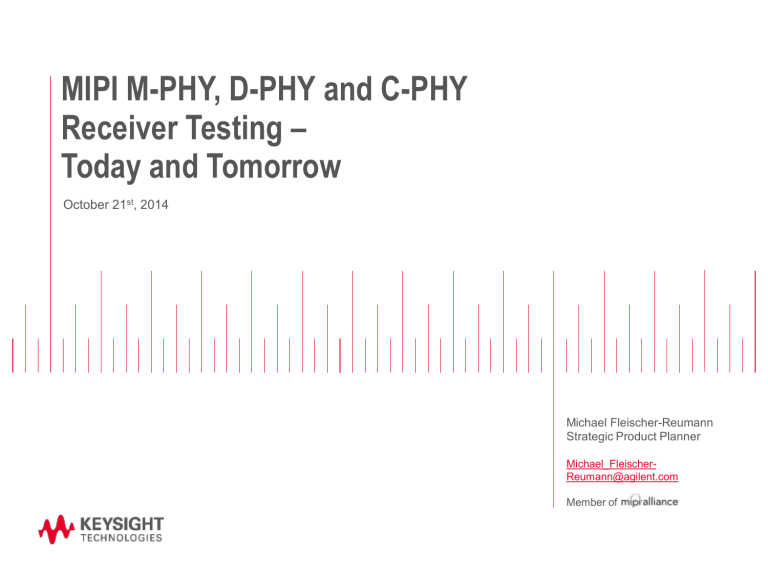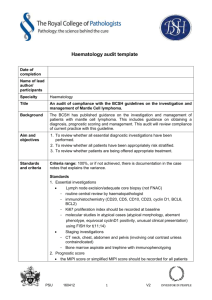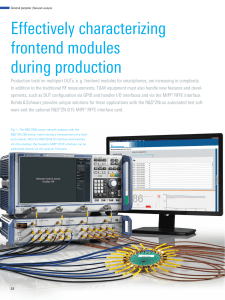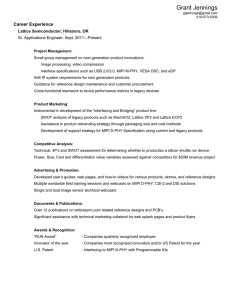
MIPI M-PHY, D-PHY and C-PHY
Receiver Testing –
Today and Tomorrow
October 21st, 2014
Michael Fleischer-Reumann
Strategic Product Planner
Michael_FleischerReumann@agilent.com
Member of
Agenda
– MIPI Overview, history and recent changes
– RX test: recap of methodology
– M-PHY key features, changes in spec & methodology
– D-PHY recap of basics, signaling, LP- and HS- modes
– C-PHY intro on 3-wire 3-level signaling
– Keysight test solutions M8000 based
– Summary, links, QA
Page 2
Technology Challenges in Mobile Computing
Page 3
3
MIPI M-PHY Receiver Test Webinar
August 2013
Technology Challenges in Mobile Computing
Page 4
4
MIPI M-PHY Receiver Test Webinar
August 2013
MIPI = Mobile Industry Processor Interface Goals
• Structure the intestines of mobile
devices ranging from smartphones
to wireless-enabled tablets and
netbooks
• Benefit the entire mobile industry by
establishing standards for hardware
and software interfaces
• Enabling reuse and compatibility
making system integration less
burdensome
• The distinctive requirements of
mobile terminals drive the
development of MIPI Specifications
- Power saving / battery life
- Bandwidth on demand
Page 5
MIPI M-PHY Receiver Test Webinar
August 2013
MIPI = Mobile Industry Processor Interface Goals
• Structure the intestines of mobile
devices ranging from smartphones
to wireless-enabled tablets and
netbooks
• Benefit the entire mobile industry by
establishing standards for hardware
and software interfaces
• Enabling reuse and compatibility
making system integration less
burdensome
• The distinctive requirements of
mobile terminals drive the
development of MIPI Specifications
- Power saving / battery life
- Bandwidth on demand
M-PHY
C-PHY
D-PHY
Page 6
MIPI M-PHY Receiver Test Webinar
August 2013
MIPI’s Layered Approach for Application Standards
MIPI RX Testing –
Today & Tomorrow
Page 7
Page 7
Why Three Different PHY-layer Standards?
2013 and before
– D-PHY
• Used for camera (CSI-2) and display (DSI) applications
• Source synchronous, forwarded ½ rate clock
• Electrical specifications (parasitic capacitances and return loss (RL)) allow usage of
established, relatively inexpensive semiconductor process
• Complex signaling, different amplitudes and data format for Low Power (LP) and High
Speed (HS) mode and non-differential “pattern sequence” signaling transition from LP
to HS-mode and vice versa
• Rev. 1.0 / 1.1 with a continuous data rate range up to 1.0 / 1.5Gb/s respectively
– M-PHY
•
•
•
•
Proposed high BW successor of D-PHY addressing camera and display applications
Embedded clock and PLL-type CDR
Discrete data rates (Gears) up to approximately 12Gb/s; sufficient for quite a while
Differential signaling and same amplitude in both HS- and LP- mode
MIPI RX Testing –
Today & Tomorrow
Page 8
Agilent / Keysight Solutions for MIPI RX PHY-test
2013 and before
M-PHY
J-BERT N4903B
D-PHY
ParBERT 81250
2013
2014
2015
MIPI RX Testing –
Today & Tomorrow
Page 9
Why three different PHY-layer standards?
2014 onwards
– M-PHY
• Reluctance of camera group to adapt M-PHY because of
- Specified lower parasitic capacitance / better RL demands more expensive
semiconductor process than for D-PHY
- Discrete instead a “agile” data rates
- 8B/10B coding overhead of 25%
– C-PHY started
•
•
•
•
•
New 3-wire / 3 level data format allowing transmission of >1 bit / symbol
Embedded clock, CR based on logic and encoding rules
HS mode w/ toggle rates reaching continuously up to 2.5Gbaud / 5.75Gb/s
LP mode identical to D-Phy
Even more complex signaling (HS mode3 w/ 3 wire 3-level signaling) level)
– D-PHY extended
• Rev. 1.2 w/ max data rate 2.5Gbs (achieved through RX deskew)
• Rev. 2.x started, data rate project beyond 4.5 Gb/s (6.5Gb/s)
MIPI RX Testing –
Today & Tomorrow
Page 10
Agenda
– MIPI Overview, history and recent changes
– RX test: recap of methodology
– M-PHY key features, changes in spec & methodology
– D-PHY recap of basics, signaling, LP- and HS- modes
– C-PHY intro on 3-wire 3-level signaling
– Keysight test solutions M8000 based
– Summary, links, QA
Page 11
About Receiver (RX) testing
– RX testing
An RX test is used to determine an RX’s capability to properly
detect the digital signal content, even for worst-case impaired
input signals. For this testing…
MIPI RX Testing –
Today & Tomorrow
Page 12
MIPI M-PHY Receiver Test Webinar
August 2013
About Receiver (RX) testing
– RX testing
An RX test is used to determine an RX’s capability to properly
detect the digital signal content, even for worst-case impaired
input signals. For this testing…
1. A Bit Error Ratio Tester’s (BERT) Pattern Generator (BERT PG)
is used to emulate a system’s TX plus channel thus generating
a data signal containing the impairments to be expected at the
RX input when it is operating in a target system.
This signal has to be calibrated according to the specification.
MIPI RX Testing –
Today & Tomorrow
Page 13
MIPI M-PHY Receiver Test Webinar
August 2013
About Receiver (RX) testing
– RX testing
An RX test is used to determine an RX’s capability to properly
detect the digital signal content, even for worst-case impaired
input signals. For this testing…
1. A Bit Error Ratio Tester’s (BERT) Pattern Generator (BERT PG)
is used to emulate a system’s TX plus channel thus generating
a data signal containing the impairments to be expected at the
RX input when it is operating in a target system.
This signal has to be calibrated according to the specification
2. The input of the RX under test is stimulated with this signal
MIPI RX Testing –
Today & Tomorrow
Page 14
MIPI M-PHY Receiver Test Webinar
August 2013
About Receiver (RX) testing
– RX testing
An RX test is used to determine an RX’s capability to properly
detect the digital signal content, even for worst-case impaired
input signals. For this testing…
1. A Bit Error Ratio Tester’s (BERT) Pattern Generator (BERT PG)
is used to emulate a system’s TX plus channel thus generating
a data signal containing the impairments to be expected at the
RX input when it is operating in a target system.
This signal has to be calibrated according to the specification
2. The input of the RX under test is stimulated with this signal
3. Proper detection of the digital content is monitored in a suitable
fashion to determine performance according to target BER
–
MIPI RX Testing –
Today & Tomorrow
Page 15
MIPI M-PHY Receiver Test Webinar
August 2013
Agenda
Page 16
– MIPI Overview, history and recent changes
– RX test: recap of methodology
– M-PHY key features, changes in spec & methodology
– D-PHY recap of basics, signaling, LP- and HS- modes
– C-PHY intro on 3-wire 3-level signaling
– Keysight test solutions M8000 based
– Summary, links, QA
MIPI RX Testing –
Today & Tomorrow
M-PHY Link Example
MIPI M-PHY
•
•
•
•
Lanes are unidirectional
Signaling: differential
8B/10B coded
Transmisssion may
appear in burst
• Embedded clock
• PLL type CDR, needs to
synch at the beginning
of every burst
MIPI M-PHY options
– High speed and (lower speed) low power mode (same as in D-PHY)
– High and low voltage swing operation can be commonly selected for both modes
– Terminated (100 Ohm) or not terminated operation (for power saving purposes) can
individually be selected per mode
MIPI RX Testing –
Today & Tomorrow
Page 17
Low Power Modes
High Speed Modes
MIPI M-PHY Data Rates and Module Types
fref = 19.2, 26, 38.4 or 52 MHz
NT = Not Terminated
RT = Resistively terminated
• High Speed Gears / data rates valid for both module types
• Type II module only used for Dig_RF_v4
MIPI RX Testing –
Today & Tomorrow
Page 18
Jitter Cocktail for Receiver Tolerance Test
M-PHY Gear 1 & 2
Jitter Cocktail consists of
• ISI generated through Conformance Channel and Replica Trace
• Dual band RJ
• Dual-tone SJ
Step
Action
J-BERT
parameter
Target Value
Pattern
TIE-HPfilter
RJ
0.10 UIpp
7.9mUIrms
clk/2
(1010)
1/30UI
1
Adjust wideband RJ (>fL_RX) to achieve STRJ
2
Add low frequency RJ (<1/30UI) to achieve
RJ=TJ-DJ
BUJ
0.17UIpp
13.4mUIrms
clk/2
(1010)
fL_RX *
3
Turn all RJ off;
calibrate SJ (f_SJ1, f_SJ2, f_SJ3, f_SJ4)
PJ2
0.15 UI,pp
CJTPat
off
4
Keep all RJ off but keep PJ2 on;
calibrate STSJ (240 MHz) to achieve
STDJ=0.2UI (STSJ=STDJ-DDJ) or DJ=0.35UI
PJ1
0.35 UI,pp
CJTPat
off
5
Turn all callibrated jitter on. Calibrate to
prorated eye mask at BER 10-6
PJ2, Amp VDIF_AC=43mV CJTPat
1-TJ=0.52UI
off
*) f L_RX = FC-RX = 1/2MHz
MIPI RX Testing –
Today & Tomorrow
Page 19
Jitter Cocktail for Receiver Tolerance Test
M-PHY Gear 3 (and 4)
Jitter Cocktail consists of
• ISI generated through Conformance Channel and Replica Trace
Simplification
• Single RJ (broad-band)
• Dual-tone SJ
Step Action
J-BERT
parameter
Target Value
Pattern
TIE-HPfilter
1
Add wideband RJ (> 10MHz) to achieve
RJ=TJ-DJ
RJ
0.17UIpp
13.4mUIrms
clk/2
(1010)
fL_RX *
2
Turn all RJ off;
calibrate SJ (f_SJ1, f_SJ2, f_SJ3, f_SJ4)
PJ2
0.15 UI,pp
CJPat
off
3
Keep all RJ off but keep PJ2 on;
calibrate STSJ (240 MHz) to achieve
STDJ=0.2UI (STSJ=STDJ-DDJ) or DJ=0.35UI
PJ1
0.35 UI,pp
CJPat
off
4
Turn all callibrated jitter on. Calibrate to
prorated eye mask at BER 10-6
PJ2, Amp VDIF_AC=45mV CJTPat
1-TJ=0.52UI
off
*) f L_RX = FC-RX = 1/2/4MHz
MIPI RX Testing –
Today & Tomorrow
Page 20
M-PHY Definition of RX Eye Diagram
Gear 1 & 2
Gear 3 & 4 3
– Geometry (channel lengths) supported is identical for all Gears despite increasing loss:
• G3 requires TX de-emphasis (3.5 / 6dB depending on swing and actual channel)
• G4 additionally requires receiver equalization (RX-EQ) with CTLE and one-tap DFE
– Target BER is 10-10: however, to shorten measurement time, calibration is done with 3x106 samples
for BER = 10-6 using “prorated” mask w/ larger eye- width and –height (EW , EH) (CTS 3.0)
– Calibration for G4: post processing of measured data emulating reference package and RX-EQ
– TJ, DJ, STTJ and STDJ are normative with continuous signal
DJ and STDJ are informative with burst using TIEpp method
MIPI RX Testing –
Today & Tomorrow
Page 21
Setup for M-PHY RX Test and Calibration
Cal-plane
Stress Signal Generation and Calibration according to CTS
RT-Oscilloscope
for Gear1 to Gear3
Replica
Trace
TP
RX
DUT
ISI Conformance Channel
Breakout Trace
Test board with Replica Traces
TX
– creating test point (TP) for calibration
– equivalent to the ASIC-input pins
Ref
Clk
ASIC
Internal Loopback
or Error counter
BERT
Pattern
Generator
w/ TTCs
100 Ohm
Differential
Probe
Custom
Test Board
MIPI RX Testing –
Today & Tomorrow
Page 22
Setup for M-PHY RX Test and Calibration
Cal-plane
Stress Signal Generation and Calibration
for Gear 4
(1)
small EW/EH
(2)
larger EW/EH
Replica
Trace
ISI Conformance Channel
TP
EQ
RX
DUT
Breakout Trace
Test board with Replica Traces
TX
– creating test point (TP) for calibration
– equivalent to the ASIC-input pins
Ref
Clk
ASIC
Internal Loopback
or Error counter
BERT
Pattern
Generator
w/ TTCs
(3)
Custom
Test Board
MIPI RX Testing –
Today & Tomorrow
Page 23
Gear 4 Stress Calibration using Scope Postprocessing
EH <
40mV!
EW <
0.47UI
w/o EQ
EH ~
82mV
EW ~
.53UI
w/ EQ
w/ EQ
w/o EQ
EH<40mV, EW<470mUI
EH~82mV, EW~530mUI
MIPI RX Testing –
Today & Tomorrow
Page 24
Setup for M-PHY RX Test
Stress Signal Generation and Calibration according to CTS
– At gear 4 rates subtle differences may already exist in waveforms
measured with oscilloscopes from differrent vendors
– Vendor specific postprocessing SW may increase differencies
– In order to increase consistency SIGTest SW proposed to be used
for postprocessing and analysis of eye parameters, i.e. EW and EH
MIPI RX Testing –
Today & Tomorrow
Page 25
PHY Layer Error Detection
– Challenges with different protocols:
• Asymmetrical lane configuration (e.g. 2x HS upstream / 1x LS
downstream)
• Test modes not mandatory (optional normative / recommendation)
• Specific method defined in protocol spec, not in PHY spec
– Various error detection methods:
• Line Loopback (i.e. bit level loopback)
• Logic Loopback (i.e. protocol layer loopback)
• PPI (=Parallel Processor Interface i.e. parallel data output)
• IBER (=Internal Bit Error Ratio Counter)
– Not all MIPI applications have settled on preferred test option
– Not possible to provide turnkey solution, RX testing always has
a custom portion
MIPI RX Testing –
Today & Tomorrow
Page 26
Outlook Mipi M-PHY
M-PHY Spec Roadmap
– V4.0 WG approved draft to be ready by October 31 st 2014
– V4.0 Spec December 2014
• Aligns with UniPro 1.8 schedule, which depends on 8b10b
– V4.1 Spec October proposed for 2015
• Tighten spec/conformance of digital interface (RMMI)
• Protocol/PHY optimizations
- Coding scheme w/ less overhead than 8B/10B
- Fine data rate granularity (cont range of data rates??)
MIPI RX Testing –
Today & Tomorrow
Page 27
Agenda
– MIPI Overview, history and recent changes
– RX test: recap of methodology
– M-PHY key features, changes in spec & methodology
– D-PHY recap of basics, signaling, LP- and HS- modes
– C-PHY intro on 3-wire 3-level signaling
– Keysight test solutions M8000 based
– Summary, links, QA
Page 28
D-PHY Universal Lane Module Functions
– Lane consisting of 2 wires, Dp and Dn
– TXs and Rxs: Bidirectional
– Contention Detection (LP only)
– Two set‘s of TXs / RXs (HS & LP)
– HS-mode:
• Small Amplitude, terminated (option)
• Data format: NRZ
• Signaling: differential
– LP-mode:
• Large Amplitude, unterminated
• Data format: RZ
• Signaling: non-differential
MIPI RX Testing –
Today & Tomorrow
Page 29
D-PHY Two Data Lane Phy Configuration
– Source synchronous forwarded double data rate clocking
– Data-rate completely agile, no discrete operating frequencies, continous range
– RX testing is basically stressing set-up- and hold- time conditions
(eye closure mainly due to DDJ and skew between Data and Clock)
MIPI RX Testing –
Today & Tomorrow
Page 30
D-PHY Physical Layer Timing Diagram
Transition LP to HS mode, HS_clk active earlier / longer
High speed mode,
Differential signaling, 100 ohm termination,
source synchronous with double data rate clocking
Low power mode
Unterminated, not differential, clock embedded within data
MIPI RX Testing –
Today & Tomorrow
Page 31
D-PHY Physical Layer Timing Diagram
Transition HS to LP mode and back, no HS_clk in LP mode
Low power mode
Unterminated, not differential, clock embedded within data
High speed mode,
Differential signaling, 100 ohm termination,
source synchronous with double data rate clocking
MIPI RX Testing –
Today & Tomorrow
Page 32
Agenda
– MIPI Overview, history and recent changes
– RX test: recap of methodology
– M-PHY key features, changes in spec & methodology
– D-PHY recap of basics, signaling, LP- and HS- modes
– C-PHY intro on 3-wire 3-level signaling
– Keysight test solutions M8000 based
– Summary, links, QA
Page 33
C-PHY Universal Lane Module Functions
– TXs and RXs: Bidirectional
– Contention Detection (LP only)
– Two set‘s of TXs / RXs (HS & LP)
– HS-mode:
• Small Amplitude, always 50
W “star-type“ termination
• Data format: 3-phase / 3-level
• Signaling: 3 wires forming a
HS-lane
– LP-mode:
• Large Amplitude, unterminated
• Data format: RZ
• Signaling non-differential
MIPI RX Testing –
Today & Tomorrow
Page 34
Transition HS to LP mode and back
D-PHY
MIPI RX Testing –
Today & Tomorrow
35
Page 35
3 Phase Encoding Concept for C-PHY (HS-mode)
– A data encoding technique utilyzing
trios rather than pairs of wires
• 50 Ohm “star-type“termination
• Utilyzes differential receivers,
rejecting common mode noise
• Drivers work similar to D-PHY but
control 3 instead of 2 outputs
– Both clock and data are encoded
and transported together in a single
trio
• Always a transition at every
symbol boundary, which simplifies
clock recovery and allows data
rate to be completely agile
A
B
C
MIPI RX Testing –
Today & Tomorrow
Page 36
3-phase Signal Examples 1Gsym/s
HS signal only
A
B
C
A B C
•
Clean HS signal no jitter no skew
•
separated (offset-shifted, left) and overlaid (same offset, right)
note: for each UI each voltage level appears exactly once!
MIPI RX Testing –
Today & Tomorrow
Page 37
C-PHY Block diagram
– Coding rules and possible
wire states:
• 27 possible wires states
• 6 allowed wire states
(+x -x, +y, -y, +z, -z)
only those states with
different voltage on each
wire
• From one symbol to the
next symbol only 5 wire
states are possible,
because a transition is
required for CR
• Theoretical coding gain:
log2(5) = 2.32
• Practically usable gain is
2.28 by sending 16 bits in
7 symbols
Drawing showing T2 Driver type w/ active mid-level
MIPI RX Testing –
Today & Tomorrow
Page 38
C-PHY Block diagram
Drawing showing T2 Driver type w/ active mid-level
midpoint voltage is stable
at +V/2
(except for asymmetries
during transitions (to be
filtered by capacitor))
MIPI RX Testing –
Today & Tomorrow
Page 39
C-PHY Block diagram
50W
100W
Drawing showing T2 Driver type w/ active mid-level
MIPI RX Testing –
Today & Tomorrow
Page 40
C-PHY Block diagram
100W
50W
MIPI RX Testing –
Today & Tomorrow
Page 41
C-PHY possible TX Realization (principle)
T2 Driver type:
active mid-level, extra pair of Transistors w/ 100W
T1 Driver type:
passive mid-level w/ both transistors „open“
MIPI RX Testing –
Today & Tomorrow
Page 42
C-PHY Signal Characteristics
High Speed Only
Transmit: A, B and C
1.0
0.5
0.0
UI#: 1
2
3
1.0
0.5
Receive: A-B, B-C and C-A
-0.5
-1.0
Unit Intervall #1
A-B = 0.0-0.5
= -0.5 = weak 0
B-C = 0.5 – 1.0
= -0.5 = weak 0
C-A = 1.0 – 0.0
= 1.0 = strong 1
Unit Intervall #2
A-B = strong 1
B-C = weak 0
C-A = weak 0
Unit Intervall #3
A-B = weak 1
B-C = weak 1
C-A = strong 0
MIPI RX Testing –
Today & Tomorrow
Page 43
C-PHY Eye Diagram and Mask Test
High Speed Only, A-B
Strong-1
Weak-1
0V threshold
Weak-0
Strong-0
•
Clock is recovered from the earliest edge of a symbol transition.
•
A delay circuit with negative hold time is used to sample data.
Supposed to be more resistant to noise and jitter on the system.
MIPI RX Testing –
Today & Tomorrow
Page 44
Jitter Tolerance Calibration and Measurement
1. Calibrate the Rise/Fall times from the test equipment generator to approx. 115ps
using 20%-80% transition time converter
2. Calibrate the Eye width of three differential signals A-B, B-C, A-C to be 0.7UI by
adding Jitter (e.g. DCD) over the already present switching jitter, of course using
proper C-PHY clock recovery algorithm.
3. Add ISI jitter by either using a HW channel or SW-programming of the generator to
meet the 0.3UI of channel ISI requirement.
4. Tune the Amplitude and the amount of ISI to meet the eye mask requirement of +40
to -40mV for EH and 0.4UI for EW.
(Allow 10% of variation in calibration over the time scale wrt. the targeted eye mask
spec.)
5. After generating the worst case eye as per the mask requirements, Check for any
errors in the receiver by comparing the received pattern with the receiver expected
pattern and varying DC Common mode.
MIPI RX Testing –
Today & Tomorrow
Page 45
Key Features of PHY-Layer Standards
Rev
Max Data
Rate (Gb/s)
Data
format
HS
LP
HS
1.0, 1.1
1.5, continous
RZ
NRZ
1.2
2.5, continous
2.0
4.5, continous
C-PHY
1.0
2.5, continous
RZ
3-ph
embedded
Logical
None
M-PHY
1.0, 2.0
1.5/3 discrete
PWM
NRZ
embedded
PPL-based
None
3.0
6, discrete
TX
4.0
12, discrete
TX & RX
D-PHY
Clocking
Clock
Recovery
EQ
Forward Source
Synchronous
(DDR)
NA
None
None
TX
MIPI RX Testing –
Today & Tomorrow
Page 46
Release Status of Standards and Related CTSs
Standard
version
Status
CTS
Status
D-PHY
1.0, 1.1
released
rev 1.0
released
1.2
released
wip
2.0
wip
not started
C-PHY
1.0
wip
vers 1.0r0.5
wip
M-PHY
1.0
released
vers 1.0r0.95
released
2.0
released
vers 1.0r0.95
released
3.0
released
ver 3.0r16
wip
4.0
wip
not started
wip = work in progress
MIPI RX Testing –
Today & Tomorrow
Page 47
Agenda
– MIPI Overview, history and recent changes
– RX test: recap of methodology
– M-PHY key features, changes in spec & methodology
– D-PHY recap of basics, signaling, LP- and HS- modes
– C-PHY intro on 3-wire 3-level signaling
– Keysight test solutions M8000 based
– Summary, links, QA
Page 48
How Can All of This Be Tested?
Keysight M8000 Series of BER Test Solutions
– Modular system in AXI form factor /frame consisting of
• HW modules M8041A and M8051A plus M8070 SW
forming Keysight J-BERT M8020A
• modular up to 4 channels enabling channel skew measurements
• Very much comparable to N4903
– Very well suited for M-PHY
– ...
MIPI RX Testing –
Today & Tomorrow
Page 49
Test Setup Using Agilent J-BERT N4903B
RT-Oscilloscope
N4915-60001
100 Ohm
Differential
Probe
1:1 match of CTS proposed set-up with actual Keysight J-BERT set-up
ISI conformance channel relaized through N4915 60001 SATA ISI trace (2)
MIPI RX Testing –
Today & Tomorrow
Page 50
MIPI M-PHY Receiver Test Webinar
August 2013
Test Setup Using Agilent J-BERT M8020A
J-BERT M8020A
RT-Oscilloscope
N4915-60001
100 Ohm
Differential
Probe
1:1 match of CTS proposed set-up with actual Keysight J-BERT set-up
ISI conformance channel relaized through N4915 60001 SATA ISI trace (2)
MIPI RX Testing –
Today & Tomorrow
Page 51
MIPI M-PHY Receiver Test Webinar
August 2013
Test Setup Using Agilent J-BERT M8020A
J-BERT M8020A
RT-Oscilloscope
N4915-60001
100 Ohm
Differential
Probe
M8020A‘s modularity addresses multichannel applications
MIPI RX Testing –
Today & Tomorrow
Page 52
MIPI M-PHY Receiver Test Webinar
August 2013
Jitter Cocktail for Receiver Tolerance Test
M-PHY Gear 1 & 2
Jitter Cocktail consists of
• ISI generated through Conformance Channel and Replica Trace
• Dual band RJ
• Dual-tone SJ
Step
Action
J-BERT
parameter
Target Value
Pattern
TIE-HPfilter
RJ
0.10 UIpp
7.9mUIrms
clk/2
(1010)
1/30UI
1
Adjust wideband RJ (>fL_RX) to achieve STRJ
2
Add low frequency RJ (<1/30UI) to achieve
RJ=TJ-DJ
BUJ
0.17UIpp
13.4mUIrms
clk/2
(1010)
fL_RX *
3
Turn all RJ off;
calibrate SJ (f_SJ1, f_SJ2, f_SJ3, f_SJ4)
PJ2
0.15 UI,pp
CJTPat
off
4
Keep all RJ off but keep PJ2 on;
calibrate STSJ (240 MHz) to achieve
STDJ=0.2UI (STSJ=STDJ-DDJ) or DJ=0.35UI
PJ1
0.35 UI,pp
CJTPat
off
5
Turn all callibrated jitter on. Calibrate to
prorated eye mask at BER 10-6
PJ2, Amp VDIF_AC=43mV CJTPat
1-TJ=0.52UI
off
*) f L_RX = FC-RX = 1/2MHz
MIPI RX Testing –
Today & Tomorrow
Page 53
4. Short Term DJ Cal w/ J-BERT N4903B
Caused by CJPAT over Board Trace + HSSJ
Keep RJ/BUJ off and PJ2 on
Turn on PJ1 with frequency set to
>1/30UI e.g. 240MHz
Measure DJ with TIE turned off
Calibrate DJ to target value of MTDJ = 350mUI
MIPI RX Testing –
Today & Tomorrow
Page 54
4. Short Term DJ Cal w/ J-BERT M8020A
Caused by CJPAT over Board Trace + HSSJ
Keep RJ/BUJ off and PJ2 on
Turn on PJ1 with frequency set to
>1/30UI e.g. 240MHz
Measure DJ with TIE turned off
Calibrate DJ to target value of MTDJ = 350mUI
MIPI RX Testing –
Today & Tomorrow
Page 55
4. Short Term DJ Cal w/ J-BERT M8020A
Caused by CJPAT over Board Trace + HSSJ
Property
list
PJ1 On
PJ2 On
BUJ Off
Keep RJ/BUJ off and PJ2 on
Turn on PJ1 with frequency set to
>1/30UI e.g. 240MHz
RJ Off
Mesure DJ with TIE turned off
Calibrate DJ to target value of MTDJ = 350mUI
MIPI RX Testing –
Today & Tomorrow
Page 56
How Can All of This Be Tested?
Keysight M8000 Series of BER Test Solutions
– Modular system in AXI form factor /frame consisting of
• HW modules M8041A and M8051A plus M8070 SW
forming Keysight J-BERT M8020A
• modular up to 4 channels enabling channel skew measurements
• Very much comparable to N4903
– Very well suited for M-PHY
– Test Automation: SW Keysight N5990A option 165 &
Bitifeye Frame Generator BIT-2060-0001-0
– ...
MIPI RX Testing –
Today & Tomorrow
Page 57
Building Blocks for a Test and Related SW Products
Test
Setquencer
Keysight
N5990A Test
Automation SW
List of parameters to be
calibtrated along w/
measurement set-up
AutoCal
Cal tables
Test Automation
Patterns & Parameters
List of (CTS-specified)
tests to be performed
along w/ measurement
set-up per test
Sequence / pattern editor
for all relevant data
formats also determining
PHY-parameters
Bitifeye
Frame
Generator
Editor for PHY-parameters
RX
Result capturing
DUT
TX / Register
/ DLL
Documentation
of Results
MIPI RX Testing –
Today & Tomorrow
Page 58
N5990A Automation Software
Setup of Test Flow
• Parameters of selected item
• Calibrations
- HS, NRZ (RT)
- LP, PWM (NT)
• RX tests
- HS, NRZ (RT)
- LP, PWM (NT)
• Parameters of
selected item
• Calibrations
• HS, NRZ (RT)
• LP, PWM (NT)
• RX tests
• HS, NRZ (RT)
• LP, PWM (NT)
MIPI RX Testing –
Today & Tomorrow
Page 59
N5990A Automation Software
DUT Configuration, Integration of IBERReader
– Connect (string connection): will be called once at the beginning of the test
run. The connection string can contain a customized address (like a COM
port) to access to the tool which is able to read out the internal counters of
the DUT
– Init (string mode): will be called once at the beginning of each test. This
allows to configure the DUT into the test mode of a particular test (HS or
PWM, Gear, Functional Test)
– ResetDUT (): will be called once at each test point. This allows to reset
error counters, or set the DUT in a defined mode to be ready for the next
test point
– GetCounter (out double errorCounter, out double bitCounter) will be called
after or during a test point execution. The errorCounter value can contain a
CRC- or symbol-error, and the bitCounter can contain a bit or burst
counter. The counters can provide just simple indicators, if errors
happened and if the DUT was able to receive data, or in case of both error
and bit counters being implemented, to calculate BER
– Copy the compiled MPhyBerReader.dll into the ValiFrame Program Files
folder
– A new entry in the BER Reader List will be visible
– After selection of the Custom BER Reader the N5990A automation
software can connect with the DUT
MIPI RX Testing –
Today & Tomorrow
Page 60
MIPI M-PHY Receiver Test Webinar
August 2013
How Can All of This Be Tested?
Keysight M8000 Series of BER Test Solutions
– Modular system in AXI form factor /frame consisting of
• HW modules M8041A and M8051A plus M8070 SW
forming Keysight J-BERT M8020A
• modular up to 4 channels enabling channel skew measurements
• Very much comparable to N4903
– Very well suited for M-PHY
– Test Automation: SW Keysight N5990A option 165 &
Bitifeye Frame Generator BIT-2060-0001-0
– How to address C-PHY / D-PHY ?
• We now integrate Keysight AWG modules
substituting 8041/51A‘s NRZ PGs
while still operating under a typical
BERT use model
MIPI RX Testing –
Today & Tomorrow
Page 61
Setup for C-PHY: M8190A, 5 Slot Frame, Embedded Controller
1-lane
C-PHY
DUT
embedded controller (1 slot)
MIPI RX Testing –
Today & Tomorrow
Page 62
Setup for C-PHY: M8195A, 5 Slot Frame, Embedded Controller
1-lane
C-PHY
DUT
embedded controller (1 slot)
4X channel density (4 channels in 1 slot module vs 2 channels in 2 slot module)
MIPI RX Testing –
Today & Tomorrow
Page 63
Setup for C-PHY: M8195A, 5 Slot Frame, Embedded Controller
1-lane
C-PHY
DUT
embedded controller (1 slot)
Alternative setup: M8195A, 2 slot frame, embedded Controller
1-lane
C-PHY
DUT
MIPI RX Testing –
Today & Tomorrow
Page 64
Setup for C-PHY: M8195A, 5 Slot Frame, Embedded Controller
3-lane
C-PHY
DUT
3 AWG modules capable of driving up to 12 wires ( up to 4x C-PHY lanes)
required synchronization module not shown
MIPI RX Testing –
Today & Tomorrow
Page 65
Realization of "C-PHY-GUI" within M8070A SW
C-PHY Frame Generator integrated M8070 SW / M8000 BER solution
Definitions available for:
– Pattern & coding
– Low Power to High
Speed mode
transition
MIPI RX Testing –
Today & Tomorrow
Page
Page 66
Realization of "C-PHY-GUI" within M8070A SW
C-PHY Frame Generator integrated M8070 SW / M8000 BER solution
Definitions available for:
– Pattern & coding
Parameter editor for
Impairments
– Low Power to High
Speed mode
transition
MIPI RX Testing –
Today & Tomorrow
Page
Page 67
Agilent / Keysight Solutions for MIPI RX PHY-test
2013 and before
M-PHY
J-BERT N4903B
D-PHY
ParBERT 81250
2013
2014
2015
MIPI RX Testing –
Today & Tomorrow
Page 68
Agilent / Keysight Solutions for MIPI RX PHY-test
2015: Complete Solutions
M8000 family of
BER test solutions
M-PHY
J-BERT N4903B
J-BERT M8020A
J-BERT M8020A /
M8070 / 85A
AWG M8190A
w/ M8085 special SW
AWG M8195A /
M8070 / 85A
C-PHY
D-PHY
ParBERT 81250
2013
AWG M8190A
w/ MATLAB script
2014
2015
MIPI RX Testing –
Today & Tomorrow
Page 69
Agenda
– MIPI Overview, history and recent changes
– RX test: recap of methodology
– M-PHY key features, changes in spec & methodology
– D-PHY recap of basics, signaling, LP- and HS- modes
– C-PHY intro on 3-wire 3-level signaling
– Keysight test solutions M8000 based
– Summary, links, QA
Page 70
Advantages of Keysight Solution
– All PHY-standards to be addressed from M8000 platform
– CTS-conformant test setup, characterization and test
– Simple, repeatable automated and unattended calibration and test
execution using automation SW N5990A opt 165
– Variety of error counting methods from BERT ED to IBER reader
interface supported by N5990A test automation SW
– For M-PHY: direct match between J-BERT N4903B / M8020A
capabilities and M-PHY required jitter cocktail
– Flexible Jitter generation to characterize RX beyond specifications to
determine margins
– BitifEye Frame Generator SW BIT-2060-0001-0 allowing to choose
and mix LP and HS traffic as in real application and to place custom
data hassle-free into compliant M-PHY bursts
MIPI RX Testing –
Today & Tomorrow
Page 71
Summary
We discussed
– Goals of MIPI alliance
– Recent development and reasoning of PHY-layer standards
– Important capabilities and aspects of RX testing of different PHYlayers
– Introduction to C-PHY
– Rx test requirements, current and future keysight solutions
MIPI RX Testing –
Today & Tomorrow
Page 72
Literature
– www.keysight.com/find/J-BERT
– www.keysight.com/find/M8020A
– www.keysight.com/find/mipi-mphy
– http://mipi.org/
– Application Brief M8020: http://cp.literature.agilent.com/litweb/pdf/5991-3959EN.pdf
– Application note:
http://cp.literature.agilent.com/litweb/pdf/5991-2848EN.pdf
– Recorded Webinar, M-PHY: http://techonline.com/electrical-engineers/educationtraining/webinars/4416663/Demystify-MIPI-M-PHY-Receiver-Physical-Layer-TestChallenges
– Data sheet M8020A:
http://literature.cdn.keysight.com/litweb/pdf/5991-3647EN.pdf
– Data sheet N5990A : http://literature.cdn.keysight.com/litweb/pdf/5989-5483EN.pdf
MIPI RX Testing –
Today & Tomorrow
Page 73
Keysight MIPI Total Solution Coverage
Transmitter
Characterization
Receiver
Characterization
Impedance/Return
Loss Validation
Protocol Stimulus and
Analysis
DSAQ93204A Infiniium
N4903B/M8020A JBERT
E5071C ENA Option TDR
U4421A D-PHY CSI-2 / DSI
Analyzer and Exerciser
U4431A M-PHY Analyzer (UFS,
UniPro, CSI-3, SSIC, M-PCIe)
M8190 AWG
U7238B D-PHY, U7249B
M-PHY, N5467B C-PHY UDA
InfiniiMax Probes
DCA 86100D Wideband
sampling oscilloscope
81250A ParBERT
Scope Protocol Decoder
Switch matrix
N5465A InfiniiSim
N2809A PrecisionProbe
N1055A
TDR/TDT
N5990A Automated
characterization
N8802A CSI-2 / DSI
N8807A DigRF v4
N8808A UniPro
N8818A UFS
N8809A LLI
N8819A SSIC
N8820A CSI-3
N8824A RFFE
54754A
TDR/TDT
Industry’s highest analog
bandwidth, lowest noise
floor/sensitivity, jitter
measurement floor with
unique cable/probe correction
Highest precision jitter lab
source with automated
compliance software for
accurate, efficient, and
consistent measurement
Precision impedance
measurements and
S-Parameter capability
Fast upload and display,
accurate capture, intuitive
GUI and customizable
hardware. Correlate physical
and protocol layer.
MIPI RX Testing –
Today & Tomorrow
Page 74
The End
Thank you!
Questions?
Contact:
Michael_Fleischer-Reumann@keysight.com
Phone: +49 7031 464 8420
Page 76
76
MIPI M-PHY Receiver Test Webinar
August 2013
Three PHYs “at a glance”
Characteristic
Primary use case
M-PHY v3.1
Performance driven,
bidirectional
packet/network oriented
interface
D-PHY v1.2
Efficient unidirectional
streaming interface, with
low speed in-band
reverse channel
C-PHY v1.0
Efficient unidirectional
streaming interface, with
low speed in-band
reverse channel
HS clocking method
Channel compensation
Embedded Clock
Equalization
DDR Source-Sync Clock
Data skew control
relative to clock
1 lane per direction, dual- 1 lane plus clock,
simplex, 2 pins each (4 ) simplex, 4 pins
Embedded Clock
Encoding to reduce data
toggle rate
1 lane (trio), simplex, 3
pins
SA: 250mV (peak)
LP: 1300mV (peak)
LP: 1300mV (peak)
LA: 500mV (peak)
Data rate per lane (HS)
HS-G1: 1.25, 1.45 Gb/s
HS-G2: 2.5, 2.9 Gb/s
HS-G3: 5.0, 5.8 Gb/s
(Line rates are 8b10b
encoded)
Data rate per lane (LS)
10kbps – 600 Mbps
Bandwidth per Port (3 or 4 ~ 4.0 – 18.6 Gb/s
lanes)
(aggregate BW)
HS: 360mV (peak)
80 Mbps to ~2.5 Gbps
(aggregate)
HS: 425mV (peak)
80 Mbps to 2.5 sym/s
times 2.28 bits/sym, or
max 5.7 Gbps
(aggregate)
Typical pins per Port (3 or
4 lanes)
10 (4 lanes, 1 lane clock) 9 (3 lanes)
Minimum configuration
and pins
Maximum transmitter
swing amplitude
10 (4 lanes TX, 1 lane
RX)
< 10 Mbps
< 10 Mbps
Max ~10 Gbps per 4-lane Max ~ 17.1 Gbps per 3port (aggregate)
lane port (aggregate)
MIPI RX Testing –
Today & Tomorrow
Page 77
Reference CTLE
Copyright © 2013
MIPI Alliance. All
rights reserved.
Page
Reference CTLE and DFE
Copyright © 2013
MIPI Alliance. All
rights reserved.
Page






